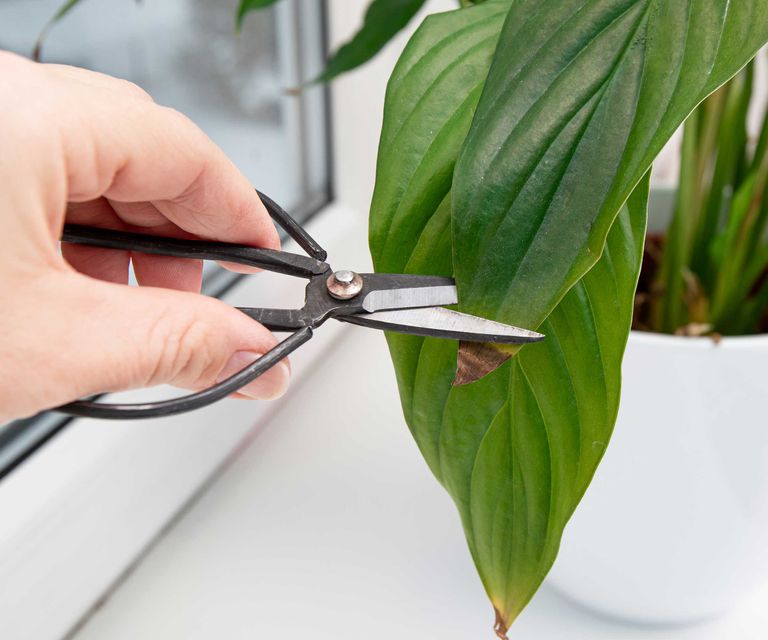How to remove dead Peace lily flowers?
Spathiphyllum flowers, known for their unique appearance, are often questioned by new Peace Lily owners about the need for deadheading. However, deadheading is beneficial for Peace Lilies, as they last around a month after unfurling and turn brown and shrivel up. Once this happens, the dead flowers should be removed near the plant’s base using clean, angled cuts with disinfected shears. Deadheading not only enhances the plant’s appearance but also invigorates it and encourages fresh new blooms. The best way to remove dead Peace Lily flowers is to follow these recommendations.
To know why the leaves of peace lily turn brown? And Should I cut the brown tips off my peace lily? Read the relevant article!

Your Peace Lily’s growth requires an investment of energy, with each leaf, root, stalk, and blossom representing an investment. Flowers are particularly expensive as they do not contribute income, photosynthesize, absorb nutrients, or store energy. There is a limit to how many flowers a Peace Lily can support at once, and once a bloom forms, the plant must spend energy on maintaining it. Deadheading, or cutting off dead flowers, allows the plant to grow faster and frees up energy for fresh new flowers. Deadheading also helps the plant bloom more often, as it frees up part of the energy budget for fresh flowers. Dead blossoms are not very pretty and can be removed to make the Peace Lily look like a snack again. By removing dead blossoms, you can save energy and reduce the energy consumption of your Peace Lily.

How to Know When a Peace Lily Flower Dies
This text provides a comprehensive guide to the life cycle of a Spathiphyllum bloom, allowing readers to understand how to deadhead a Peace Lily when the flowers begin to die off. Each blossom on a Peace Lily is arranged on a separate stalk, with the white “petal” wrapping around it in a twisted cone shape. The spadix, a bumpy spike, protects the flowers as they develop. The tiny flowers grow in rows along the stubby cylinder at the center of the bloom.
The spathe, a characteristic hood behind the spadix, takes a while to unwrap and form its hood. It is in the female phase for 4-5 days, with fuzzy cone tips opening to receive pollen. After this, puffy, wispy anthers pop up between the spadix bumps, appearing dusty and swollen. This phase lasts another 4-6 days. The bloom stays healthy and white for another week or two after the male phase ends. If the plant is in good shape, the flowers may last up to two months after unfurling. The spathe will turn green, brown, sag, and crumple, indicating that it’s time to deadhead.
How to Remove Dead Peace Lily Flowers
Deadheading a Peace Lily is a simple process that requires only a few supplies. First, use pruning shears to remove the dead flowers when they are just starting to turn brown. Disinfect the blades with rubbing alcohol, hydrogen peroxide, or 1 part bleach in 9 parts water to remove bacteria that might cause the plant to become sick. If you are not sensitive to the plant’s juices, gloves may be necessary.
Sanitize the shears and remove the thin stalk holding up the dead flower, as it won’t produce new leaves or blooms. Cut the cut at a 45-degree angle to reduce the likelihood of water droplets collecting on the cut end and incubating fungal infections. Repeat this process, disinfecting each time, until you have removed every spent bloom. Be sure to scoop out any plant parts that fall into the pot to prevent the spread of fungus gnats. This will help protect your Peace Lily from pests.
Helping Your Peace Lily Blooms Last Longer
- Deadheading your Peace Lily is all well and good. But you also want to keep those blooms looking healthy and gorgeous for as long as possible. Here are a few strategies you can use to get the most out of your Peace Lily flowers:
Spathiphyllum plants require at least 6 hours of bright indirect light daily for longer blooming. Check shadows near the plant during high sun to ensure the spot is too dim for robust Peace Lily flowering. - To ensure the longevity of a Peace Lily, it is essential to keep it out of direct sunlight, as too much sun can cause premature browning of flowers and burn of foliage. If the plant is near a southern or western window, consider swaying it back or hanging a thin curtain. How much light does a peace lily need?
- Maintain a temperature above 65 degrees Fahrenheit and humidity above 60% to ensure your plant’s flowers last longer in conditions resembling its ancestral jungles.
- To ensure the longevity of Peace Lilies, it is crucial to maintain a small amount of moisture in their roots, as allowing them to droop can cause early flower wilting. Regularly check the soil and water when the top inch feels dry.
Do You Cut Off Dead Peace Lily Flowers?
Once the blooms on a Peace Lily plant turn brown, they need to be trimmed for better growth. This will encourage your plant to bloom frequently. You should remove the dead flowers by cutting the stalk at the base. But remember that flowers can die due to an underlying issue as well.
Peace Lily Flower Cycle
With proper plant care, your Peace Lily will start blooming in spring or early summer. The flowering is triggered by short day/long night photo periods in the cold months.
The white bracts on a Peace Lily are a modified version of the leaves. The bracts have tiny white flowers attached to the stalk in the middle. The delicate but magnificent flowers will eventually die.
As the blooming season comes to an end, the white bracts turn green and start to droop.
You should perform deadheading to get rid of these spent flowers and improve the appearance of your plant.
Deadheading can be defined in simple words as the removal of dead flowers to make room for new ones.
The color of Peace Lily flowers can help you decide when your plant is ready for deadheading.
| Common Name | Peace lily, spath lily |
| Botanical Name | Spathiphyllum spp. |
| Family | Araceae |
| Plant Type | Perennial |
| Mature Size | 1–4 ft. tall, 1–4 ft. wide (indoors), up to 6 ft. tall (outdoors) |
| Sun Exposure | Partial |
| Soil Type | Moist but well-drained |
| Soil pH | Acidic |
| Bloom Time | Spring |
| Flower Color | White, yellow |
| Hardiness Zones | 11–12 (USDA) |
| Native Area | Central America, Asia |
| Toxicity | Toxic to pets3 and people4 |
Final Thoughts
Deadheading your Peace Lily is one of those small gardening tricks that can have a big impact. By cleaning up the wilting blooms, you’re helping your plant stay beautiful and grow strong. Once you make a habit of removing dead flowers from your Peace Lily, you’ll see for yourself what a difference it makes.











